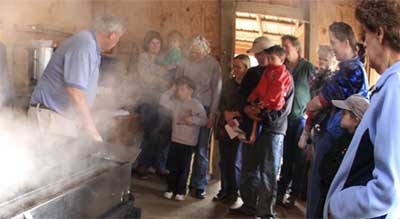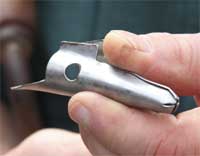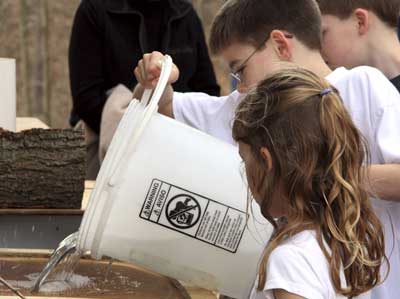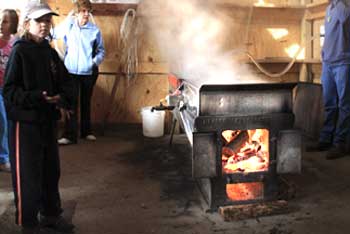

Sap to produce maple syrup can be collected from any native species of maple, but in Ohio, sugar and black maples are the first choice when they are available. Making maple syrup from sap requires boiling off water until the desired sugar concentration is achieved. Sugar and black maple usually have considerably higher sap sugar contents than red and silver maple, resulting in less sap needed and less time and energy required to produce a given volume of syrup. Good syrup can be made from red or silver maple, but it is more likely to be cloudy. Tapping season is also likely to be shorter when tapping red or silver maple because both species tend to break bud at an earlier date than sugar or black maple. Once the trees begin to break bud, chemical changes within the sap cause syrup to have an unpleasant flavor, often referred to as a "buddy" taste.
Maple syrup can be produced on a small scale with very little equipment, but there are some standard items required to do the job correctly. You may already have many of these items or can buy them at a local store. Others, such as metal collecting spouts (called spiles), an hydrometer, collecting buckets or bags, and finishing filters, are unique to maple production. Depending on the item, it might be made, purchased second hand from a maple producer, or purchased from a maple equipment supplier. Check with your county Ohio State University Extension office, ODNR Division of Forestry Service Forestry office, or a local maple producer for the names of suppliers.

Equipment you will need to properly produce maple syrup includes:
A drill or carpenter's brace with a sharp bit the proper size for the spouts being used (e.g., 7/16" bit for traditional spouts or 5/16" for most small diameter spouts).

A metal or plastic collecting spout (spile) for each tap hole. The spouts should be the type intended for use with buckets or bags.
A collecting container for each tap hole. Buckets should be covered with a lid to prevent rainwater from diluting the sap and keep out debris.
Some type of storage tank, bucket, or other container to store sap before boiling. This container is not absolutely necessary in a small hobby operation, but it allows you to collect more sap, particularly during periods of large sap flow. Plastic tanks such as those sold to store and transport agricultural chemicals work well. Make sure it is made of food-grade material and has never contained harmful chemicals.
A large pan and a heat source for boiling down the sap. The size of the pan and the heat source will depend on the amount of sap to be processed. At a minimum, however, the pan should be at least 6", and preferably 8" deep to prevent boiling over. If possible, boiling should be done outside the house, or some method should be available to vent the steam outside the house. Steam given off during boiling carries small amounts of sap and syrup that can make surfaces very sticky.
A thermometer calibrated to the nearest degree with a readable scale in the range of 200 - 230F. Some candy thermometers are satisfactory.
A hydrometer and hydrometer cup are inexpensive optional pieces of equipment that are used to measure the density of hot or cool syrup. Syrup that is not dense enough will be thin, weak flavored, and more likely to spoil; syrup too dense will form sugar crystals in the storage container.
Wool, orlon, or other type filter for filtering the finished syrup while it is hot. These filters are available from maple equipment suppliers. Use only filter material that is intended for use in food processing. Do not try to use paper coffee filters; the pores are too small.
Containers for the finished syrup. Containers are available from maple equipment vendors or canning jars may be used. Containers must provide an airtight seal and tolerate a hot filling and sealing at a temperature of at least 185F.

Some sap flow may occur any time during the dormant season, after a maple loses its leaves, when cool nighttime temperatures (below freezing) are followed by days when there is a rapid warming above freezing (ideally, to about 40F). Tapping for maple sap, however, is generally done only in the spring when the weather is more predictable and the sap sugar content is high.
Some producers tap by the calendar, routinely tapping each year on or before a certain date such as the second or third week of February. Others, particularly those with a relatively small number of taps who collect with buckets or bags, watch the weather. When suitable weather is predicted, they tap.
Sap flow from a tapped tree will not occur every day throughout the tapping season, but only when conditions are right. Sap can be collected for syrup production until just before tree buds begin to expand, usually sometime in late March or early April, depending on the weather and location in the state. Sap collected and processed into syrup after bud expansion begins results in "buddy" syrup, which has a distinctly unpleasant flavor sometimes described as "bitter butterscotch." Trees should be at least 10" - 12" in diameter when measured 4.5' above ground level, before they are tapped.
In recent years many syrup producers have gone to a more conservative tapping guideline than in the past, placing 1-tap in trees 12" - 18" in diameter, 2- taps in trees 19"- 25" in diameter, and 3-taps in trees larger than 25". This conservative tapping level is particularly recommended for trees that have been subjected to severe stresses in recent years from such factors as insect defoliation and drought. Reducing the number of taps does not result in a proportional reduction in sap collected because with fewer taps the sap yield per tap hole generally increases substantially.

Because sap flow depends on weather, it is not always consistent. Some days no sap will flow; other days, as much as a quart to a gallon or more of sap may flow during a flow period (several hours to a day or more). During the season, an average tap will produce 6 - 10 gallons of sap. Slightly more than 10 gallons of 2% sugar-content sap are required to produce one quart of syrup.
To produce high-quality syrup, sap should be collected as quickly as possible. It is best to collect sap the day it runs and process it immediately into syrup. The longer sap is left in buckets or bags the more likely it is to spoil, particularly during warm weather. During periods of cold temperature, sap can often be stored for a couple of days under the proper storage conditions without seriously reducing the quality of syrup it will produce.
Usually, the season will provide enough sap in timely runs to make all the syrup you desire and have time to produce. Although not absolutely necessary, it is often desirable to filter sap through a cloth filter before it is boiled. This filtering removes any debris, such as twigs or pieces of leaves or bark, which might have fallen into the sap. Several layers of cheesecloth will serve as a filter or a reusable (cleanable) maple sap filter can be purchased.
Sap is made into syrup by boiling off water, which increases the sugar content to 66% and causes chemical changes that darken the syrup and provide its characteristic taste. The amount of sap required to produce a gallon of syrup depends on the sugar content of the sap. On the average, in Ohio, sap averages about 2% sugar content, requiring 43 gallons of sap to produce a gallon of finished syrup. If the sap sugar content is higher (it varies from tree to tree, with weather, and other factors), less sap will be needed to make a gallon of syrup; if lower, more sap will be required.
Sap is placed in a pan and heated to remove excess water. More sap is added as water evaporates until a suitable amount of concentrated sap is present. The evaporation process is then continued with no additional sap and the entire batch is "finished" to the desired density. To batch-process syrup, a large pan, such as a roaster (teflon coated pans are ideal), is needed. The pan should be at least 6" and preferably 8" deep to prevent foaming over.
Rates of evaporation from a flat bottom pan are highly variable. Depending on many factors, including the size of the heat source and the type, size, and construction of the pan, they may range from as little as 3/4 to more than 1-1/2 gallons of water for each square foot of liquid surface. A 12" square or 14" in diameter circular pan both have one square foot of liquid surface. Remember, 43 gallons of sap are required to produce one gallon of syrup 42 gallons of water must be evaporated. It will normally require somewhere between 28 and 56 hours of continuous boiling (and sap refilling) if a pan with one square foot of liquid surface is used. By comparison, a gallon of syrup can be produced in between 9 and 18 hours using a rectangular 24" x 18" pan (3 square feet of liquid surface). Obviously, the larger the pan, the more quickly the evaporation process will be completed.

Do not fill the pan completely, as boiling sap usually rolls and foams. Remember to boil outside the house or at least vent the steam outside. Bring the sap to a boil. If foaming occurs, skim the foam off and discard. Maple producers use a defoamer to reduce the amount of foaming. Defoamers are not, however, commonly used when batch processing small amounts of sap. If foaming over is a problem, the common solution is to use a deeper container. If needed, commercial defoamers are available from maple equipment suppliers or a flavorless vegetable oil may be used. Use the defoamer sparingly (a small drop at a time) as excessive amounts may give the syrup an off-flavor.
Continually replace the sap as evaporation occurs. To avoid burning or scorching, monitor the heat carefully (don't let the heat get too high), and keep at least 1-1/2" of liquid in the pan. The risk of scorching increases as the density of the liquid increases.
The higher the sugar concentration in a sugar solution, the higher the temperature at which the solution boils. As you evaporate water from sap you will discover that the temperature of the boiling liquid is increasing. Finished syrup boils at 7.1F above the boiling temperature of water. When you decide to finish your syrup, stop adding sap and continue the evaporation process until the liquid is boiling at a temperature 7.1F above that of boiling water. Monitor the heat very carefully as "finish point" is approached so that you do not scorch the syrup or go beyond the desired density. Be sure the thermometer bulb is not touching the side of the pan, or it will not read correctly.
Finishing syrup at the correct temperature is critical to producing quality syrup that stores well. Be sure the temperature reaches the finish point. If you go beyond the finish temperature to more than 7.5F above the temperature of boiling water, add a little more sap and bring the syrup to the correct finish point.
Since the boiling point of water varies with location (elevation) and weather (pressure systems), you should determine the boiling point of water when you are making syrup. This is easily done by placing your thermometer in a pan of vigorously boiling water. Note, that since the boiling point of sap is essentially the same as water, the boiling temperature of sap when it just begins to boil is a suitable estimate of the boiling point of water.
Again, be sure the thermometer bulb does not touch the pan side. Once the syrup has reached the desired boiling temperature, it is ready for filtering and packaging. If you have a hydrometer, now is the time to check and verify the density of the syrup. The density should be at least 66 Brix (66 percent solids) and not much more than about 67 to 67.5 Brix. Less than 66 and it is not legally maple syrup, it will be very thin, and will not store as well. Much higher than 67.5 and sugar crystals are likely to form in the storage container. For instructions on the use of an hydrometer, consult the North American Maple Syrup Producers Manual referenced at the end of this fact sheet.
Filter hot syrup through clean wool or synthetic syrup filters to remove sugar sand and other suspended solids. After filtering, syrup that is to be used immediately can be cooled and refrigerated. The rest of the syrup should be packaged hot in tightly sealed, clean, airtight containers. For safe storage, syrup temperature for packaging should be at least 180 and preferably 185F. After filling and sealing the containers, immediately invert them for a short time to flood the container neck and lid bottom with hot syrup.